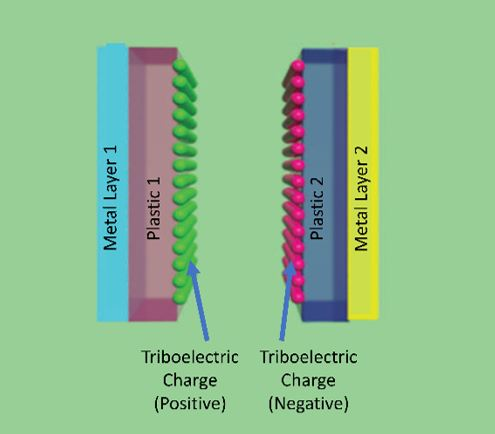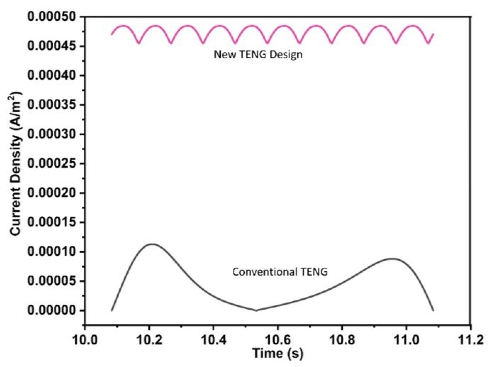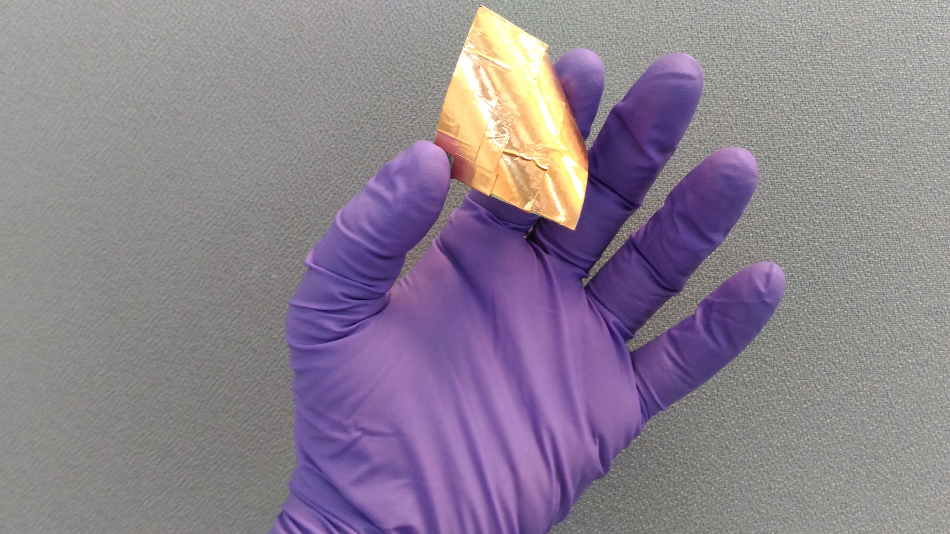EPSRC Doctoral Prize Fellow, Dr Ishara Dharmasena, speaks to AZoNano about their groundbreaking triboelectric nanogenerator (TENG) technology that has the potential to convert our movements into electricity.
How did you begin your research into energy harvesting technology?
I was interested in renewable energy technologies and their impact on our lifestyle and the environment since my undergraduate years back in Sri Lanka. However, it was during my PhD project at the University of Surrey that I started researching energy harvesting technologies, specifically those that have the potential to convert human motion into electricity such as the triboelectric nanogenerator (TENG) technology.
Following the completion of my PhD project, I started TENG energy harvesting activities at Loughborough University, focusing on the design and application aspects of TENGs toward powering the next generation of portable and smart electronics.
What are triboelectric nanogenerators (TENGs) and how are they revolutionary in the energy industry?
Triboelectric nanogenerators (TENG) are small-scale energy generators that can convert the energy from movements in our surroundings (e.g. human motion, machine vibrations, vehicle movements, wind, and wave energy) into electricity.
These generators work based on the combination of two common effects - “triboelectric charging” and “electrostatic induction”. Triboelectric charging or static charging is typically an undesired effect we experience in everyday life. Static charging is the reason why a balloon rubbed on our hair can stick to a wall or attract small pieces of paper, while it also causes lightening, and, clothing to stick to our skin on a dry day.
TENGs are made of dielectric materials such as plastic, which can accumulate triboelectric charges when they contact or rub against each other (Fig. 1). When this occurs, one of the surfaces will be positively charged, and the other, negatively charged.

Figure 1: Structure of a TENG. Image Credit: Loughborough University.
There are a number of advantages to TENG technology. These devices can be constructed using commonly available low-cost plastics and polymeric materials using simple manufacturing techniques.
In a TENG device, a metal coating is deposited on the back of these dielectric materials, which act as electrodes. When the triboelectrically charged materials move back and forth relative to each other, they can generate an electrical current that flows between the electrodes (through an external circuit) due to electric fields. This is known as “electrostatic induction”. A complete explanation of the working principle of these devices was first presented through our previous work in 2017 (Energy & Environmental Science 10 (8), 1801-1811).
TENGs are extremely versatile and are constructed in a wide variety of sizes (few mm2 to several m2), shapes and weights, including ultralight and ultrathin designs. They can also be made stretchable and flexible if needed.
Compared to other energy technologies such as piezoelectric and electromagnetic energy harvesters, TENGs efficiently capture energy from low-frequency movements such as human motion. These characteristics make TENGs an ideal candidate for next-generation low-power and wearable electronic applications, facilitating their much-desired autonomous and maintenance-free operation.
Moreover, TENGs can work as self-powered sensors, i.e. devices that can sense pressure, force, and movement, while generating their own energy. Therefore, TENGs are considered as one of the most promising methods of powering future portable and wearable electronic applications such as implantable electronics, smart textiles, medical devices, IoT and 5G-related sensors, smart pavements, smart floors, mobile phones and tablets.
What challenges have past researchers faced when producing TENG technology?
The TENG technology was first introduced in 2012, by Prof. Z.L. Wang’s research group at Georgia Institute of Technology (USA).
The main challenges of this technology included the lack of understanding of their behavior, limited knowledge on how to engineer TENGs to get maximum outputs, low power outputs and energy conversion efficiencies, high internal impedances, and discontinuous and sporadic variations of power outputs.
Due to the work of scientists around the world, including our group, several solutions have been developed to address most of these challenges. However, several major challenges still exist and need to be addressed before TENGs can become an efficient and reliable energy source for commercial low-power electronics.
Can you explain why TENGs have, until now, been incompatible with electronic devices already on the market?
Despite many promising TENG prototypes being demonstrated over the years, there are several hurdles of the technology to overcome to make them compatible with commercial electronic devices.
Firstly, to enable the operation of TENG as a power source, their power generation characteristics need to be engineered. This includes improving the output power as well as decreasing the TENG internal impedance.
The commercial electronics we find on the market are typically low impedance devices, whereas the internal impedance of TENGs is extremely high (typically MΩ to GΩ range for slow movements). Consequently, the generated power cannot be effectively extracted from the TENG. In our previous study, we demonstrated several techniques to effectively tackle this issue (Advanced Energy Materials 8 (31), 1802190).
Secondly, the discontinuous and unpredictable power generation behavior has been a key issue related to this technology, as it adversely affects the reliability and stability of TENGs. Commercial electronics typically require a continuous and uniform energy input, however, TENGs have so far struggled to fulfil this requirement without the help of extensive external circuits.
What sets your TENG device apart from traditional generators?
We have introduced a new method to construct a contact mode TENG device that generates a current output comparable to a DC output signal. Therefore, unlike previous TENG devices, this design can produce a consistent power output to directly power various electronic applications. Below is a brief description of the technological details.

Figure 2: Outputs of a conventional TENG and the DC TENG. Image Credit: Loughborough University.
In the DC TENG technology introduced, an assembly of TENG units (poles) are used as a single device, where they are systematically excited to obtain a phase difference among their outputs. This systematic excitation is obtained through their geometry and spatial arrangement. The outputs with different phases are then superimposed to obtain the final DC output signal (Fig. 2).
The current outputs of a conventional TENG (after rectification) is as shown in the image above (Fig. 2). The current is irregular, so one cannot use this current to continuously power an electronic device which typically requires a continuous current supply. Imagine if you want to light a bulb or power a small calculator etc., such tasks will be very difficult using this current signal.
As seen in Fig. 2, the current output from the new TENG design shows significant improvement. In our work, we demonstrated the ability of the DC TENG to continuously power an array of LEDs and a photodetector, confirming the enhanced capabilities of our design.

Image Credit: Loughborough University
Your research team found a way to produce a direct current from a triboelectric nanogenerator. How important was this for the future of wearable technology and portable energy harvesting?
The invention of DC TENG technology arguably addresses the most significant drawback of TENGs at present - the inconsistent and variable output generation. This enables the possibility of using TENGs to directly power electronic devices, when continuous mechanical energy is available, opening up a wide range of potential future applications.
Moreover, it helps to reduce the amount of energy consumed by additional energy management circuits, increasing the overall system efficiency. Therefore, as we mentioned in our paper, the construction of DC TENG devices is extremely important to uplift TENG technology as a practical and viable candidate for powering future wearable and portable electronic technologies.
How could these small, flexible generators be used in the future and what industries would benefit most from such a device?
Researchers are working on a wide range of future TENG applications in healthcare, personal electronics, security and communication sectors, exploiting both energy harvesting and sensing capabilities of this technology.
TENGs could be integrated into wearable electronics and smart textile products to develop self-powered health sensors, electronic-skin applications and activity monitoring units. A closely related area is the powering of portable and mobile electronic devices. Moreover, TENGs can be integrated into the Internet of Things (IoT), 5G technology, big data-related developments for autonomous environmental sensing, smart buildings, and smart communication devices.
What are the next steps in your research?
We intend to further develop TENG technology to make them more efficient, practical and user friendly. This includes designing, fabricating and optimizing the performance of TENGs to incorporate different device sizes, structures, material types and applications.
Where can readers find more information?
The DC TENG paper discussed in this interview can be found here: https://www.sciencedirect.com/science/article/pii/S2211285520304444
Some of our related articles can be found below:
https://pubs.rsc.org/en/content/articlelanding/2017/ee/c7ee01139c
https://onlinelibrary.wiley.com/doi/full/10.1002/aenm.201802190
https://www.sciencedirect.com/science/article/pii/S2589004220305472
https://ieeexplore.ieee.org/abstract/document/8794516
https://physicsworld.com/a/maxwell-model-optimizes-motion-energy-harvesters/
Dr Ishara Dharmasena’s University of Loughborough web page:
https://www.lboro.ac.uk/departments/meme/staff/ishara-dharmasena/
About Dr Ishara Dharmasena
 Dr Ishara Dharmasena is the EPSRC Doctoral Prize Fellow at Wolfson School of Mechanical, Electrical and Manufacturing Engineering, Loughborough University. His expertise and interests include triboelectric energy harvesting, smart textiles and wearable electronics research areas.
Dr Ishara Dharmasena is the EPSRC Doctoral Prize Fellow at Wolfson School of Mechanical, Electrical and Manufacturing Engineering, Loughborough University. His expertise and interests include triboelectric energy harvesting, smart textiles and wearable electronics research areas.
In 2014, Ishara obtained his B.Sc. Engineering degree (First Class) from the University of Moratuwa (Sri Lanka). Following his B.Sc. degree, Ishara worked as a research scientist at Sri Lanka Institute of Nanotechnology (SLINTEC). He completed his Ph.D. studies at the Advanced Technology Institute, University of Surrey in 2019, studying triboelectric energy harvesting, wearable electronics and self-powered energy systems. Prior to joining Loughborough, he worked briefly as a Research Fellow at the University of Surrey.
Ishara’s work has contributed towards significant developments in the area of TENG energy harvesting and smart textiles, including the development of the distance-dependent electric field model, TENG output optimization techniques, DC TENG developments and nanotechnology-enhanced textiles.
He has received a number of awards and accolades for his work, including the ABTA Doctoral Research Award, MAS Award, and the Textile Institute Sri Lanka Gold Medal.
Ishara has appeared in BBC South Today, BBC Surrey, Sri Lanka Rupavahini, and his work has been featured in many online outlets.
Disclaimer: The views expressed here are those of the interviewee and do not necessarily represent the views of AZoM.com Limited (T/A) AZoNetwork, the owner and operator of this website. This disclaimer forms part of the Terms and Conditions of use of this website.